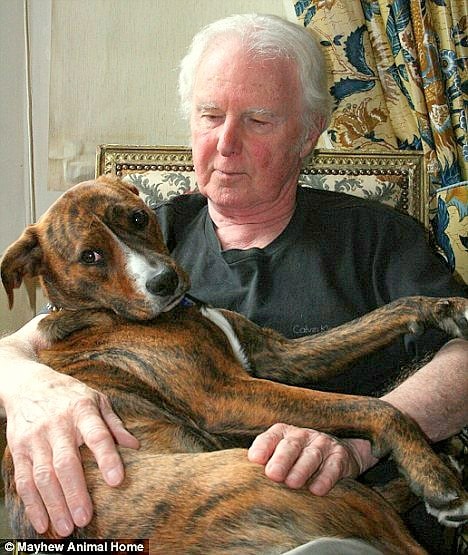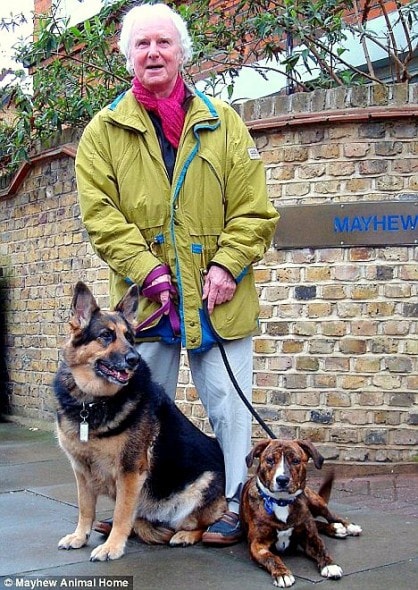
Renowned art critic Brian Sewell shares experiences of his life with dogs in the UK. We will be bringing his stories to you throughout the day – this is part 1. Parts 2 and 3 are excerpts from his book Sleeping with Dogs: A Peripheral Autobiography. Please bear in mind that pet customs vary across generations and countries. Female dogs are typically referred to as bitches, and for many years it was not common for people to spay or neuter their pets.
They’re ugly, smelly and chew my house to bits, but I wouldn’t swap my motley mutts for a Crufts champ.
Crufts, the international dog show that every year does so much to stimulate the trade in dogs, has just drawn to a close. And before the end of this week, thousands who watched it on television will have bought a puppy.
They will not stop to think about the 100,000-plus abandoned dogs who are this moment residing in rescue homes up and down the country. At least 10 per cent of these will be put down, according to figures from the Dogs Trust.
My interest in their welfare was sparked in 1966 by a scruffy little black bitch – about the size of a spaniel – who I spotted running loose in the heavy traffic of Kensington High Street. Dumping my shopping at the feet of a kindly woman at a bus stop, I dashed into the road and caught the dog by the rope that trailed from her muzzle.
She was scared, emaciated and filthy; the rope had worn a furrow over her nose and God knows when she had last been able to eat or drink.
I took her home, bathed and fed her, and let her sleep. Then I took her to the police station in Earls Court – as we were then required to do with found animals. To the question: ‘Do you want to keep her if she isn’t claimed?’ I said no, for I already had five dogs of my own.
Within a day I regretted this bitterly and returned to the police station, but she had already been taken to the pound and was untraceable. Convinced that in my thoughtlessness I despatched that little dog to certain death, she has been on my conscience ever since.
So began my life-long mission to spare the misery and potential deaths of just some of the stray and discarded dogs in Britain. For only two of the 16 dogs I have owned in my long life have I written cheques – and both were almost half a century ago.
Since then, my companions have been other people’s cast-offs without pedigree or ancestry; wished on me by a compassionate vet, found tied to park railings, or languishing in The Mayhew Animal Home near Kensal Green – of which I am now a patron.
My first dog from the Mayhew was Nusch, a fluffy little thing with long blonde hair – not my kind of dog, but exhausted by a litter of eight enormous pups and pathetic in her need.
Then came Winckelmann, who has been mine for ten full years, a grave and beautifully mannered Alsatian whose first owners wanted a ferocious guard dog, only to find that she had no capacity for savagery. It was love at first sight, across a crowded pound, and home she came.
Winckelmann ate books – old books, rare and irreplaceable. She sniffed the shelves and, having found a volume from the days when animal glue was used in binding, turned her head on one side and delicately removed it with her front teeth. There the delicacy ended in the mound of cloth and paper shredded.
At seven stone [98 pounds] when she first came, she was big and boisterous in her affection. When Miss Mabel, Diana Rigg’s Jack Russell bitch, came to stay instead of going into kennels while her owner was holidaying, they were mad with pleasure.
Miss Mabel was small enough to run under Winck as though she were a bridge; in their chase, Winck ran into the back of my knees and felled me like a log – and there I lay, helpless with laughter, flat on my back at Diana’s feet, where perhaps all men should be.
Now I have a new friend to treat me as a skittle – Lottie, my fourth dog from the Mayhew.
Lottie came when Nusch died. Five empty months lay between the two events – mourning the death of a dog is no easier with frequency – but at last I felt tough enough to fill the gap and so off went Winck and I to see what we could find at the Mayhew.

I already had another dog, Jack, also from the Mayhew, but she was less dog than a superior being; a sprite in canine form, a whippet of ethereal beauty, a fragile ornament. She had been starved almost to death, and when I held her against the light I could see through her.
I wanted a handsome pale brown bitch, bigger than Winck and boisterous. Winck – determined to remain top dog – disagreed. I could see her point. Instead, we settled on the ugliest and most pathetic-seeming alternative, the sort of dog from which most of us recoil, the sort that might well end her days for ever unwanted and unloved.
She is a Staffordshire bull terrier crossed with something rather longer-legged, with a couple of dissonant white patches. Her head is disproportionately large, her profile far from noble; full-face, she has something of the monkfish in her looks, not helped by an eye that wanders far further to the right than God intended.
To perfection she played the hangdog role of the cowed and beaten cur and abandoned mutt, as indeed she was, for she had been found early on a wet and bitter morning, tied to the railings of the Mayhew. She was so fearful that it was only with much patience that she was persuaded into letting me stroke her.
As Winck showed no objection, we came away with her. She was sick in the car. And when we reached home, Jack the whippet took one look and disappeared in a sulk. Not a good beginning.
Recovered from her nausea, Lottie raced around the garden like mad and plunged head-first into the deep end of the pond – which is 8ft deep.
It was immediately clear that she had not been house-trained and I marshalled my resources of newspaper and patience, but it did not take too long to civilise her. For Winck, as top dog, played a useful part – having an instinctively well-mannered older dog to set an example makes house-training infinitely easier.
Other matters took a little longer. Standing on her hind legs, Lottie pawed butter from the table and a whole roast chicken disappeared with only the empty dish to tell the tale.
She gnawed old Nusch’s basket and stole my glasses, crumpling the steel frame that the optician claimed was strong enough to withstand the foot of an elephant. As a woman on Wimbledon Common remarked: ‘She’s got the right teeth for chewing table legs.’
After a week or two, Lottie settled down to sleep with Jack, cuddled close and intertwined, and was even a little motherly (whippets always crave the warmth of other beings). When Jack died eight months ago, Lottie, clearly grieving, abandoned the old leather chair they shared and left it empty so that to me it was a bleak reminder of our loss.
Often I find her sitting on Jack’s grave in my garden, where all my dogs are buried, staring into space, but mostly she is funny and foolish, absurdly affectionate and curious.
Her only flaw is a tendency to break wind, silently and insidiously, the emanation sometimes so malodorous in my bedroom as to wake me from deep sleep.
Despite her studded black leather collar, Lottie is capable of menacing no one. In her company I might well cross the road to avoid a mean-looking hoodie, rather than cross their path.
She is as threatening as a child of three, often walking only on her muscular hind legs with a forepaw in my hand or leaping into my arms to make me laugh. I suspect that her first owner tried to make her aggressive but only cowed the spirit that my indulgent company has released.
I have seen a dozen dogs of her kind, cruelly scarred by wounds and the burns of stubbed cigarettes, held in an RSPCA pound, waiting as evidence to be produced at trials. In doing justice to their brutal owners, we should not do injustice to the Lotties of this world – inherently they are no more menacing than poodles.
Lottie is a warm, gentle dog, every bit as decent as the others I’ve had. I unhesitatingly commend her kind to all who shy away from them – and there are thousands sitting in rescue homes, waiting for a truly humane touch.
To read part 2, click here. To read part 3, click here.
